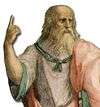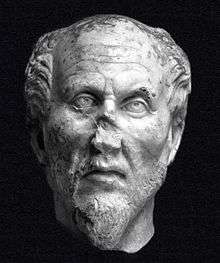Transcendentals
| Part of a series on |
| Plato |
|---|
 Plato from Raphael's The School of Athens (1509–1511) |
| Allegories and metaphors |
| Related articles |
|
The transcendentals (Latin: transcendentalia) are the properties of being. In typical accounts being is said to be One, Good and True (unum, bonum, verum). Additional properties such as Thing, Beautiful and Being (ens) are often posited as transcendentals but remain more disputed.
History
Parmenides first inquired of the properties co-extensive with being.[1] Plato then followed (see Form of the Good). However, it is in Aristotle that we first see the term transcendentals used. They were so called as they transcended (ὑπερβαίνειν huperbainein) each of his ten categories. Aristotle discusses only unity ("One") explicitly because it is the only transcendental intrinsically related to being, whereas truth and goodness relate to rational creatures.[2]
St. Thomas Aquinas posited five transcendentals: res, unum, aliquid, bonum, verum; or "thing", "one", "something", "good", and "true".[3] St. Thomas derives the five explicitly as transcendentals,[4] though in some cases he follows the typical list of the transcendentals consisting of the One, the Good, and the True.
The transcendentals are ontologically one and thus they are convertible: e.g., where there is truth, there is beauty and goodness also.
In Christian theology the transcendentals are treated in relation to Theology Proper, the doctrine of God. The transcendentals, according to Christian doctrine, can be described as the ultimate desires of man. Man ultimately strives for perfection, which takes form through the desire for perfect attainment of the transcendentals. The Catholic Church teaches that God is Himself Truth, Goodness, and Beauty.[5]
Each transcends the limitations of place and time, and is rooted in being. The transcendentals are not contingent upon cultural diversity, religious doctrine, or personal ideologies, but are the objective properties of all that exists.
Beauty, Goodness, Truth
The three terms Beauty, Goodness, Truth (καλόν kalon "beautiful,"[6] ἀγαθόν agathon "good,"[6] ἀληθές alethes "true") form a separate subgroup within the general family of transcendentals and their development can be considered separately. Although associated in particular with Platonism the ideas may have an earlier origin, appearing for example in the Bhagavad Gita to describe "words which are good and beautiful and true"."[7]
Classical Greek philosophy
In Plato's Dialogues various words representing these highest forms or ideas are mentioned, although nowhere in his works are beauty, goodness, and truth named as a specific group. In several places he mentions beauty, goodness, and justice; in other places he mentions justice, goodness, and wisdom. In Phaedrus he talks of "the ability of the soul to soar up to heaven to behold beauty, wisdom, goodness and the like".[8] In the Symposium the following passage suggests their correct order: "The true order of going is to use the beauties of the earth as steps along which to mount upwards for the sake of that other beauty: from fair forms to fair practices, and from fair practices to fair notions until he arrives at the idea of absolute beauty."[9]
Aristotle says less about beauty, goodness, and truth than Plato. Like Plato he conceived the possibility of structuring the intelligible world, but for Aristotle this resulted not in an eternal world of forms but in a set of universal "categories" by which all things could be predicated. Standing above or transcending the categories, as he noted in Metaphysics, were such concepts as being, unity, truth, goodness, and the rest.[10]
Some of Aristotle's other ideas were, however, of importance to the later development of the concept of beauty, goodness, and truth as transcendentals. Among these was the tripartite division of the human intellect into the productive, the practical and the theoretical.[11] The productive intellect was concerned, particularly in ancient Greece, with the production of beautiful objects; the practical concerned itself with ethics and the nature of the good; and the theoretical was concerned with knowledge and truth. In Topics Aristotle talked of "the theoretical, the practical and the productive and each of these signifies a relative".[12] A different type of relation underlies each of the three and in Metaphysics he gave a clue as to what these three types of relation might be: "Things are called relative in three ways: as the double to the half; as that which acts to that which is acted upon; and as the knowable to knowledge."[13]
Thus was the beginning of a structure underlying beauty, goodness, and truth premised on different kinds of relation. Beauty is understood in terms of mathematical relations, as the double to the half; goodness in terms of the causal relations of actions to their intentions; and truth in terms of the categorical relations underlying knowledge.
Neoplatonism and beyond
There was a resurgence of Platonism in the second century AD. Plotinus reduced Aristotle's ten categories to five and questioned whether "Beauty, Goodness and the Virtues should not be placed with these primary genera".[14] He concluded that both the categories and the transcendentals arise from Aristotle's three kinds of relation. These can be derived from the earlier Eleatic dilemmas of unity/plurality, motion/rest, and likeness/difference, a group of concepts which Plotinus called the "hearth of reality".[15]
At the beginning of the medieval period the philosophy of Aristotle became preeminent in the West, having been kept alive in particular by the Arabic philosophers. The term "transcendental" was introduced from Arabic philosophy by Philip the Chancellor in the early thirteenth century AD.[16] St. Thomas Aquinas wrote of three transcendentals, namely unum, bonum, and verum, or the one, the good, and the true, which he referred to as the Ens Realissimum, or the Most Real Being.[17] St. Bonaventure added the term pulchrum or beauty to the list.[18]
In the fifteenth century in Florence, Italy, Marsilio Ficino was instrumental in reviving an interest in Plato and translating some of Plato's rediscovered texts. It is to Ficino that we can safely attribute the first definitive formulation of beauty, goodness, and truth, and this is found in his Commentaries on Plato's Dialogues.[19] The idea was not without influence and in Palladio's I Quattro Libri, to take an example from architecture, is a reference to the "true, good and beautiful method of building".[20]
In Italy in 1706, Muratori wrote on beauty, goodness, and truth.[21] In France Diderot compared Le Vrai, le Bon et le Beau to the Father, Son, and Holy Spirit, and the German J. G. Sulzer in a supplement to Diderot's Encyclopaedie in 1776 translated the ideas in terms of the aesthetic, the moral, and the intellectual.[22]
Modern philosophy
The great philosophers of the eighteenth century enlightenment were well acquainted with the group of terms. Immanuel Kant's three great books, Critique of Pure Reason (1781), Critique of Practical Reason (1786), and Critique of Judgment (1790) dealt with the problems of truth, goodness, and beauty respectively. Truth was set out in terms of the categorical relations of predication and the syllogism;[23] Goodness was defined in terms of the causal or even hypothetical relations arising from one's actions; and beauty in terms of the disjunctive relation between sense and color, for example, or those relations found in the contemplation of form and proportion.
Hegel, drawing on the transcendental dialectic of Kant, introduced a complex system of sets of three among which can be found the group goodness, truth, and beauty.[24] Later in the nineteenth century in America, Charles Sanders Peirce developed a Logic of Relatives and investigated many sets of threes corresponding in varying degrees to beauty, goodness, and truth. In fact it might be concluded that Plato's original sequence for the group of terms was reinforced when Peirce wrote that "Logic follows Ethics and both follow Aesthetics".[25]
Some suggest that there has been little development of these ideas of philosophy since the nineteenth century. Indeed, Nietzsche at the end of that century rejected consideration of the group rather questionably as being "unworthy of a philosopher".[26] Yet the proliferation of twentieth century opinions dismissing the transcendentals as a serious theory in philosophy did elicit a number of influential philosophers, such as G. K. Chesterton, Edith Stein, C. S. Lewis, and Peter Kreeft, whose writings develop and re-propose truth, beauty, and goodness as the universal aspirations of humanity, which seeks an infinite good. As such, they assert, the transcendentals help human beings undergo suffering and death with hope.[27]
See also
References
- ↑ DK fragment B 8
- ↑ Cf. Aristotle, Metaphysics X.1–2. Benedict Ashley, The Way toward Wisdom: An Interdisciplinary and Intercultural Introduction to Metaphysics (University of Notre Dame Press, 2006), 175.
- ↑ Disputed Questions on Truth, Q. 1 A. 1.
- ↑ De Veritate, Q. 1 A.1
- ↑ Need a citation; the Catechism of the Catholic Church references these three at Section 41.
- 1 2 Stanford's Encyclopediae of Philosophy, Plato's Aesthetics
- ↑ Bhagavad Gita Ch.17, v.15
- ↑ Phaedrus 24
- ↑ Symposium, 211
- ↑ Aristotle, Ross D. (Methuen & Co Ltd, London, 1923)
- ↑ Topics, 145a; cf. Metaphysics, 1025b
- ↑ Topics, 144b
- ↑ Metaphysics, 1020b
- ↑ Enneads, VI, 2, 17
- ↑ Enneads, V, 1, 4
- ↑ Eco U., The Aesthetics of Thomas Aquinas, 1956, trans. Bredin H. (Radius, 1988)
- ↑ Pegis, Anton C., Introduction to St Thomas Aquinas (Random House, 1948), p. 173
- ↑ Eco U., 1956, p. 45
- ↑ The Philebus Commentary, trans. Allen M. (University of California Press, 1975), pp. 78, 110, 238
- ↑ The Four Books of Architecture (New York: Dover Publications, 1965), p. 26
- ↑ Carrit E., Philosophies of Beauty (Oxford: Clarendon Press, 1931), p. 61
- ↑ Crocker L. G., Two Diderot Studies (Johns Hopkins University Press, 1952), pp. 99-101
- ↑ Critique of Pure Reason, trans. Smith N. K. (London: Macmillan), pp. 87, 107, 113
- ↑ Logic, trans. Wallace W. (Oxford: Clarendon Press, 1975), pp. 124ff
- ↑ Collected Papers of Charles Sanders Peirce, ed. Hartshorne C. and Weiss P. (Harvard University Press, 1931), Vol. 1, p. 311
- ↑ Beardsley M. C., Aesthetics from Classical Greece to the Present (University of Alabama Press, 1975), p. 278
- ↑ Love Is Stronger Than Death
Bibliography
- Jan A. Aertsen, Medieval Philosophy and the Transcendentals: the Case of Thomas Aquinas, Leiden: Brill, 1996.
- Jan A. Aertsen, Medieval Philosophy as Transcendental Thought. From Philip the Chancellor (ca. 1225) to Francisco Suárez, Leiden: Brill, 2012.
- John P. Doyle, On the Borders of Being and Knowing. Late Scholastic Theory of Supertranscendental Being, Leuven: Leuven University Press, 2012.
- Graziella Federici Vescovini (éd.), Le problème des Transcendantaux du XIVe au XVIIe siècle, Paris: Vrin, « Bibliothèque d’Histoire de la Philosophie », 2001.
- Bruno Pinchard (éd.), Fine folie ou la catastrophe humaniste, études sur les transcendantaux à la Renaissance, Paris, Champion, 1995.
- Piero di Vona, Spinoza e i trascendentali, Napoli: Morano, 1977.
External links
- Wouter, Goris; Aertsen, Jan. "Medieval Theories of Transcendentals". Stanford Encyclopedia of Philosophy.
- Jan Aertsen on the History of Transcendentals. An Annotated Bibliography
